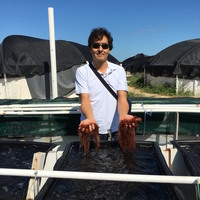
Ian G Baird
Most of my research is focused on mainland Southeast Asia, especially Laos, Cambodia and Thailand, and the peoples who come from there. My interests are varied and include: political ecology, social and spatial (re)organization, upland-lowland relations in mainland Southeast Asia, Indigenous studies, large hydroelectric dams, large-scale economic land concessions, land and resource tenure, protected areas, Hmong studies, Lao studies, Brao studies, 19th and 20th history in mainland Southeast Asia, border and boundaries studies, insurgencies and counter-insurgencies in mainland Southeast Asia, qualitative methods, Champassak, Mekong fish and fisheries, development studies, non-government organizations (NGOs), internal resettlement, Buddhism, Animism, identities and post-colonial studies.
Phone: 608-265-0012
Address: 550 N. Park St., Madison, WI, USA, 53706
Phone: 608-265-0012
Address: 550 N. Park St., Madison, WI, USA, 53706
less
Related Authors
Noel B. Salazar
KU Leuven
Muqtedar Khan
University of Delaware
Athanassios Tsikliras
Aristotle University of Thessaloniki
Tomasz Zarycki
University of Warsaw
Benjamin Isakhan
Deakin University
David Seamon
Kansas State University
John Valbo-Jorgensen
Food and Agriculture Organization of the United Nations (FAO)
Remo Caponi
University of Cologne
Daniel Robledo
Centro de Investigacion y Estudios Avanzados del IPN
Armando Marques-Guedes
UNL - New University of Lisbon
InterestsView All (36)










Uploads
Articles (Peer-reviewed) by Ian G Baird
two countries. However, a dramatic shift in political alliances – and various other internal and external factors – resulted in the CPT having to withdraw from Laos in early 1979, and falling into rapid decline in the early 1980s. This article considers the primary education that the CPT provided along the Laos–China border, and the experiences of students and teachers. The circumstances of Hmong child students trapped in China during the 1980s, and their readjustment once back in Thailand, are also discussed. The CPT’s education policies are particularly useful for understanding their ideas regarding ethnicity and language, but ultimately the approach of the CPT to ethnicity and language was not radical, and did not differ much from the approach of the government of Thailand.
bargaining or political power and limited access to markets.
especially for a number of Pangasiidae catfish and Cyprinid carps, which is having an adverse effect on local livelihoods. New dams upriver, and continued high dry-season water from existing dams, are likely to lead eventually to the increased degradation and possibly the eradication of the flooded forests along the mainstream Mekong River, unless measures are taken to address the problem.
formalization, and microfinance.
Basin fish biodiversity, and threats to it, we argue that even though no species are definitively known to have been extirpated from the Mekong River Basin to date, hydropower dam development and various other developments nevertheless pose a serious threat to fish biodiversity. Indeed, dams typically significantly block fish migrations and fish larvae distribution, cause river fragmentation, fundamentally alter river hydrology, and change water quality, all factors that have the potential to
intersect with each other and lead to significant species extirpation and extinction, or in some cases, functional extinction, when a small population remains but the important larger population is lost permanently. The circumstances are further exacerbated by the lag time between impact and when that impact becomes evident, cumulative impacts, a lack of consistent data collection, including the collection of base-line data, and insufficient post-project research related to biodiversity. We contend that much more could and should be done to ensure that the Mekong River basin’s exceptional fish biodiversity is not variously diminished and destroyed during the coming years.
two countries. However, a dramatic shift in political alliances – and various other internal and external factors – resulted in the CPT having to withdraw from Laos in early 1979, and falling into rapid decline in the early 1980s. This article considers the primary education that the CPT provided along the Laos–China border, and the experiences of students and teachers. The circumstances of Hmong child students trapped in China during the 1980s, and their readjustment once back in Thailand, are also discussed. The CPT’s education policies are particularly useful for understanding their ideas regarding ethnicity and language, but ultimately the approach of the CPT to ethnicity and language was not radical, and did not differ much from the approach of the government of Thailand.
bargaining or political power and limited access to markets.
especially for a number of Pangasiidae catfish and Cyprinid carps, which is having an adverse effect on local livelihoods. New dams upriver, and continued high dry-season water from existing dams, are likely to lead eventually to the increased degradation and possibly the eradication of the flooded forests along the mainstream Mekong River, unless measures are taken to address the problem.
formalization, and microfinance.
Basin fish biodiversity, and threats to it, we argue that even though no species are definitively known to have been extirpated from the Mekong River Basin to date, hydropower dam development and various other developments nevertheless pose a serious threat to fish biodiversity. Indeed, dams typically significantly block fish migrations and fish larvae distribution, cause river fragmentation, fundamentally alter river hydrology, and change water quality, all factors that have the potential to
intersect with each other and lead to significant species extirpation and extinction, or in some cases, functional extinction, when a small population remains but the important larger population is lost permanently. The circumstances are further exacerbated by the lag time between impact and when that impact becomes evident, cumulative impacts, a lack of consistent data collection, including the collection of base-line data, and insufficient post-project research related to biodiversity. We contend that much more could and should be done to ensure that the Mekong River basin’s exceptional fish biodiversity is not variously diminished and destroyed during the coming years.